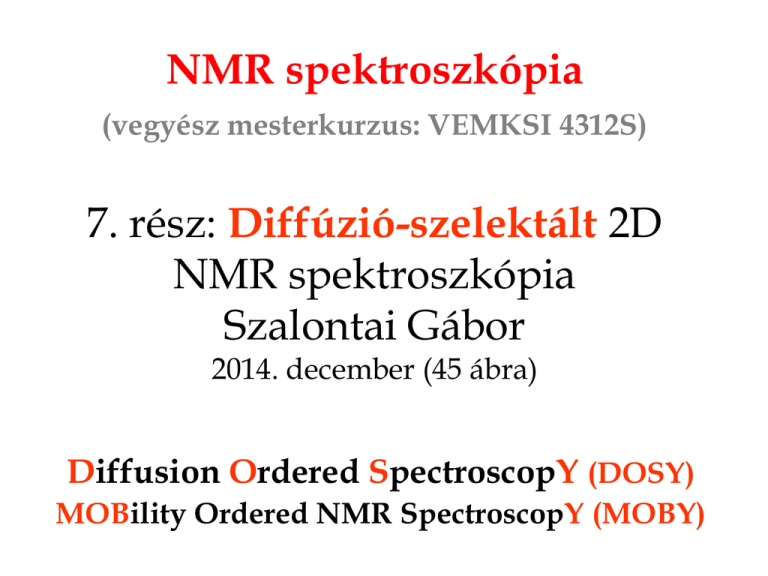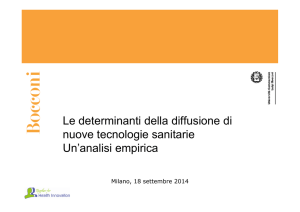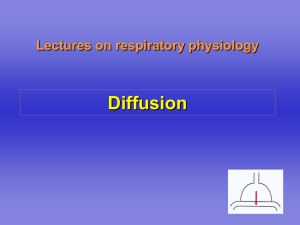
NMR spektroszkópia
(vegyész mesterkurzus: VEMKSI 4312S)
7. rész: Diffúzió-szelektált 2D
NMR spektroszkópia
Szalontai Gábor
2014. december (45 ábra)
Diffusion Ordered SpectroscopY (DOSY)
MOBility Ordered NMR SpectroscopY (MOBY)
előkészítés
kifejlődés(t1)
keveredés
mérés(t2)
Two-dimensional spectroscopy, 2D
Mérés két időváltozó (t1 és t2 ) szerint….
Cél:
- a spektrális felbontás javítása és ezáltal a spektrum
információtartalmának lényegesen jobb hasznosítása …
- a mérés hatékonyságának javítása (információ/idő tényező) …
Eredmény:
nagyobb molekulák váltak vizsgálhatóvá.
Három-, n-dimenziós spektroszkópia, 3D, nD.
2D NMR: „abundant” nuclei (1H, 19F, 31P, …) correlation
spectroscopy, the COSY experiment (vector model)
90o(x)
t1(variable)
90o(x)
t2 constant
B1(90o)x
Mz=Mcos2pnt1
Mx=Msin2pnt1
B1(90o)x
Codein:
2D (COSY) spectrum
1D spectrum
Correlations are detected between J-coupled nuclei ...
Question: can we use the second
dimension (evolution period: t1 ) to
study a molecular property (such as
shape, size, diffusion, etc.) rather than
the usual spin Hamiltonian (J-coupling,
chemical shifts, etc,)?
Answer: yes, provided these properties
have an impact on the spectrum !!.
Results: a 2D NMR spectrum
1D NMR spectrum (t2 modulation)
molecular properties (examples of t1 modulation)
t1
1. relaxation times
2. translational diffusion coefficients
3. electrophoretic mobilities
The effect of
changing
stream
gradient on
zanders
(without
diffusion)
The
diffusion
phenomenon
destroys the
order!
The effect of
changing
stream: small
and big fishes
with diffusion
(harcsa)
phenomenon
The large fishes
hardly move !
PFG (PGSE) –NMR: a Carr-Purcell spin-echo
(C.S. Johnson 1999 Progress in NMR)
Echo
at 2t: for
D amplitude
time is left
the
molecules
to move,
S(2t)
= Moexp(-2t/T
2)*
the
larger the
2
(D - d/3)]
Aexp[-Dq
gradiensek
térbeli
moleculeais
the
kódolást
longervégzik
time
is!!
Advantages
Disadvantages:
short T2 values
A the
második
a
required,
however,
maximumgradiens
limits the
signal
180
átfordító
they-as
larger
they areto
applications
strength is
small
to medium
impulzus
után
the
shorter
they
live
recovered,
size molecules,
„visszatolja”
a short
spinek
due
to
their
T
The chemical J-modulation 2
fázisát
az eredeti
prevent complete
shifts
are values!
refocusing!
refocused!
poziciójukba!
Cohen
2005
Applications: Pulse (Field) Gradient Spin
Echo experiment
• Determination of
– Translational self-diffusion coefficient, Dt
– Hydrodynamic radius, rH
– Hydrodynamic volume, VH
Theory
• Diffusion ordered NMR: translational
diffusion coefficient (Stokes-Einstein relation)
D
t
0
k BT
6 p 0 a
• a = molecular radius, o= solvent viscosity
Theory: (Relaxation) rotational diffusion
coefficient (Debye-Stokes-Einstein relation)
D
r
0
k BT
8p 0 a
4p a
3
3'
tC
3 kT
a = molecular radius, tC = molecular rotational correlation
time, o = solvent viscosity
(Dr = 1/3tC)
It follows that e.g. T1 relaxation rates must be sensitive
indicators of the molecular size too.
Most common experiments
• PGSE-STE (STimulated Echo)
• PGSE-LED ( Longitudional Eddy current Delay)
• BPP-LED (Bipolar Pulse Pairs)
PFG (PGSE) –NMR: stimulated spin-echo (STE)
(C.S. Johnson 1999 Progress)
Echo amplitude at T+2t:
S(T+2t) = Moexp[(-2t/T2)*
-/T/T1)]exp[-Dq2(D - d/3)]
T time is given to the
molecules to relax
Advantages:
according
to T
1, out of the
If 2t << T the
relaxation
extreme
narrowing
depends
mainly
on T1, (even
macromolecules
can be the
conditions
the larger
studied) the longer T is.
molecule
1
If t <<
the J-modulation
The
t 1/J
periods
are kept is
insignificant!
short
not to loose much
The
sensitivity
is T2
signal
due toloss
short
normally values!
overcompensated!
Main obstacle against good resolution: Eddy–
current caused by the gradient pulse current
Possible solutions:
-special RF coil design
-gradient pulse shaping
-active shielding of the gradient coils
-special pulse sequences (LED, BPP-LED)
PGSE – Longitudional Eddy–current Delay sequence (LED)
90o(x)
T
90o(-x)
90o(-x)
90o(x)
t
Te
90o(x)
t2
t
D
gg
d
d
The fourth pulse stores the magnetization for a
while (Te = the time allowed for the Eddy
currents to vanish) again along the z axis, the
fifth one brings it back to the x,y plane…
BPP-BiPolar Pulse – LED
180o(x)
90o(x)
180o(x)
90o(-x)
90o(x)
90o(-x)
T
90o(x)
t2
The 180 pulses
Te
cause some
loss of
signal, but
t
D
t
gg
eliminate the
d/2
effect of
background
d/2
d/2
gradients and
Often the method of choise: the composite bipolar
refocus
o
gradient pulse combination (g-180 -(-)g) provides selfchemical
compensation of the Eddy current (for short t ~ 95%).
shifts and
Attenuation factor:
produce
distortion
2
y(D+d+2t) = exp[-Dq (D - d/3-t/2)]free signals!
PGSE –NMR:
(B.Antalek 2007 Concepts)
Essential components:
The PSGE sequence
The Pulse Gradient
STimulated Echo sequence
The Bipolar Gradient
Pulse sequence
Data collection stategies
To save time and increase the S/N ratio
select the minimum number q2 values
(q=ggd )
How much is the minimum?, one has to
characterize properly even the fastest
decay!
Gradient strength, g increase must be adjusted
to the actual sample, i.e. to the distribution of
the diffusion coefficients of the components!
Data collection: according to linear, squared and
exponential functions in 8 steps
from 2% to 95% amplifier power
Applications: separation of mixture based on the
components diffusion constants
(Diffusion Ordered Spectroscopy)
• DOSY: not much more then a
convenient 2D data processing and
displaying method (Johnson 1996)
• In comparison with P(F)GSE it can
separate components of a mixture
along the diffusion dimension if
their translational diffusion differ.
PFG (PGSE) –NMR: inverz Laplace
transformation (ILT) (C.S. Johnson 1999 Progress)
Inverze Laplace
transformation:
not so trivial if the
decays are not monoexponantials
(e.g. if the peaks
overlap)
Accuracy: 3-1 % in Dt!
Data analysis methods: inversion and display in
the case of monodisperse samples
Single exponantial (Levenberg-Marquardt)
DISCRETE, SPLMOD
Limitations: if diffusion coefficient for overlapping
signals differ by less than a factor of two (three?)
and/or their S/N ratio is low (…), they cannot be
resolved in the diffusion dimension.
Data analysis methods: inversion and
display in the case of polydisperse samples
biexponantial fitting (SPLMOD)
DECRA
Continuous distribution analyses (CONTIN)
MaxEnt
Outlook of a DOSY spectrum
Log D
(m2/s)
Dt
or
D (m2/s)
1H
(or X)
chem.shift / ppm
Data inversion and display
Task: n absorption mode spectra have been
recorded with n predetermined values of q2(D-de),
(each having n frequency points or channels), these
must be transformed into 2D spectra with chemical
shifts on one axis and the distribution of diffusion
coefficients on the other.
q = ggd pulse area, e = gradient pulse shape factor
I(q, nm) = SnAn(nm)exp[-Dnq2(D - de)]
The stronger the
Ideal conditions: basic requirements
Higher
fields
or larger
the
gradient
is the
use
of other
This
meansnuclei
much
molecules
can
be
19
31
13
such
as acq.
F, Ptime
or also
C
longer
for
considered,
but
13C,
will
help
e.g.
butacurrent
itlot!
may be
the Eddy
signals
worthwhile!!
effect is
• Complete separation of
• Good signal to noise ratio proportionally larger!
• Strong and linear Bo pulse gradients
• Low constant background gradient
• Low internal magnetic field gradient
caused by susceptibility changes over the
sample
• No heat convection in the sample !
• Low to medium solvent viscosity (?)
Artifacts and pitfalls
(Ref.: Aksnes MRC 40 (2002) S139)
• Calibration of the gradient strength
• Eddy current effects
• Constant background gradients
• Unwanted flow within the sample
• Correction of effective diffusion
times
Calibration of the gradient strength Ref.:
Holz JMR 92 (1991) 115-125
The usual high• We need
absolute values in G/cm or T/m
resolution
• Gradient
coil factor = gradient
spectrometers
can calibration
constant?
produce gradients of
about
G/cm what
• Shape
factor50-60
= int(shape)/int(rectang.)
iscalibration
sufficient
• Direct
with to
secondary
analyze
molecules
up
standards
to 50 kGa.
Calibration of the gradient strength:
1H: proposed primary standards
• Water self-diffusion coefficient: 25o C
2.3 *10-9 [m2/s]
• Benzene self-diffusion coefficient: 25o C
2.207 *10-9 [m2/s]
• H2O in D2O (trace) = 1.902 * 10-9 [m2/s]
• H2O in D2O (10 m %) = 1.935 * 10-9 [m2/s]
Calibration with secondary standards
(less-common nuclei)
Ref.: Holz JMR 92 (1991) 115-125
• 13C: benzene self-diffusion coefficient:
25o C 2.207 *10-9 [m2/s]
• 31P: (C6H5)3P (3m) in C6D6 =
0.365 * 10-9 [m2/s]
19F:
(C6H5F) = 2.395 * 10-9 [m2/s]
Applications: self-assemblies
[(Pd(bifosz.)(N …..N)]1,2,3,4,5,6 tectons: 1H DOSY
2+
;
[Pd(dppp)]
L1
+
+
+
1:1
2a
+
3a
4a
5a
2:1
+
3aa
+
4aa
+
5aa
6aa
Applications: [(Pd(dppp)(N …..N)]1,2,3,4,5 tectons:
pyridine ortho protons, 1H DOSY in CD2Cl2
Dt
H
N
H
H
N
1H
N
N
H
chem.shift/ppm
Applications: [(Pd(dppp)(N …..N)]1,2,3,4,5 tectons:
acenaphthane ortho protons 1H DOSY in CD2Cl2
H H
H
H
H
H
Dt
N
N
1H
N
N
chem.shift/ppm
Alkalmazások: önszerveződő rendszerek
[(Pd(bifosz.)(N …..N)]1,2,3,4 tektonok: 1H DOSY
Applications: a mixture of small to medium
molecules: 1H DOSY in D2O
a-cyclodextrine
creatinin
pyridine
Conditions
g = 2 % - 95 %
number of steps = 8
data collection: linear
D = 50 ms
water
d = 1.7 ms
Alkalmazások: INEPT-DOSY
[(Pd(bifosz.)(N …..N)]1,2,3,4 tektonok: 31P DOSY
Alkalmazások: önszerveződő rendszerek
[(Pd(bifosz.)(4,4’-bpy…)]1,2,3,4 tektonok: 31P DOSY
Alkalmazások: önszerveződő rendszerek
[(Pd(dppp)(4,4’-bpy…)]2,3,4,5 tektonok: 1H DOSY
1
2
7
6
8
5 4
3
N
9
N
N
N
Alkalmazások: ruthenium complexes
1H DOSY dmso 298 K
[Ru(diphenylphenantroline)3]+
Dt = 130*10-12 m2/s
[Ru(methylbpy)3]+
Dt = 150*10-12
m2/s
[Ru(phenantroline)3]
+
Dt = 165*10-12 m2/s
[Ru(bpy)3]+
Dt = 180*10-12
m2/s
Alkalmazások: inclusion complexes
(CD – amino acids) 1H DOSY
Dt [*10-9 m2/s]
at 298 K
a-CD
Viscosity
[dyn s cm -1]
0.3
0.264
b-CD
0.318
g-CD
0.320
Ref.
saját
0.98
10 mM
Larive
Anal.Acta
Alkalmazások: szénhidrogének (alifás aminok
keveréke) 13C DOSY
Lassúbb
mérés, de
lényegesen
kevesebb
az átfedő
jel!
Chemical exchange in diffusion-ordered spectra,
fast-exchange (Johnson, JMR 1993 102, 210)
Small diffusiondifference
d [ppm]
Big diffusiondifference
d [ppm]
Dobs = ffreeDfree +
fboundDbound
ffree + fbound = 1
D [m2/s]
D [m2/s]
Chemical exchange in diffusion-ordered spectra,
slow exchange (Johnson, JMR 1993 102, 210)
Small diffusiondifference
d [ppm]
D [m2/s]
Big diffusiondifference
d [ppm]
D [m2/s]










